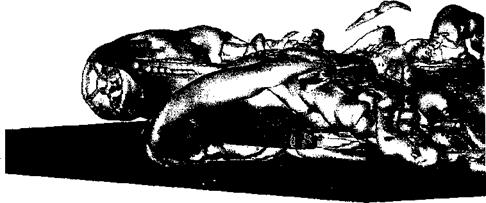Vortex Ring State
While the accurate prediction of rotor flow fields is difficult under most flight conditions, prediction of the wake dynamics during descending flight has proven to be a particularly challenging problem for the analyst. This is partly because of blade-vortex interaction (BVI) and a general susceptibility to aperiodicity of the rotor wake structure.
|
Figure 14.17 VTM calculation of the wake structure generated by a helicopter flying rearwards and to the right while very close to the ground. Notice the highly unsteady “bow vortex” on the ground plane upwind of the main rotor, and the strong interaction between the wake of the tail rotor and the main rotor under these flight conditions. Source: Richard Brown and Imperial College, University of London. |
When the rotor is descending at high rates or steep angles, the rotor can encounter an adverse condition known as the vortex ring state (VRS) – see Sections 2.13.5 and 5.7 for a description of the basic physics. Under VRS conditions, convection of the vorticity produced by the blades away from the rotor is disrupted, and the vorticity in the wake accumulates near the rotor plane, clumping or bundling together and producing large, aperiodic airloads. In aerodynamic terms, the onset of the VRS is associated with the collapse of the orderly structure of the rotor wake into a highly disturbed, irregular, recirculating flow. This behavior is related to the stability of the helicoidal wake – see Section 10.8.1.
The highly nonlinear physics of the VRS is further complicated by the likelihood of flow separation and blade stall on more highly loaded rotors during descending flight. This can occur because of the higher aerodynamic angles of attack produced on the inboard parts of the blades during descent, or, when in the VRS, the blades chop through the accumulations of vorticity engulfing the rotor. Right tests (see discussion in Section 2.13.5) show that in partial power descent near the VRS the rotor can operate without evidence of blade stall and at relatively low power, but that another state can be reached at the same airspeed and rate of descent where the rotor requires much higher power because of blade stall. This observation suggests that, in addition to the nonlinear behavior of the wake within the VRS, nonlinearity in the aerodynamics of the blades also plays an important role in governing helicopter behavior in the VRS.
Figure 14.18 shows a calculation of the wake produced by a representative four-bladed helicopter rotor when deep within the VRS. Contrast the aperiodic and somewhat chaotic nature of the wake shown at right in this figure with the orderly wake structure, shown at left, found at higher descent rates. Yet notice how, in the far wake lie the beginnings of the wake instability that will eventually travel down through the wake to engulf the rotor if the descent rate of the helicopter is reduced below the critical value for VRS onset. Although computational techniques such as the VTM and FVM have been very successful in reproducing the basic physical phenomena associated with flight in the VRS [see Brown et al. (2002) for a good discussion], much work still needs to be done in fully understanding the mechanisms leading to the onset of the VRS and the influence of the rotor
|
Figure 14.18 VTM calculated wake structure for a four-bladed rotor deep within the VRS. Left: with the helicopter in rapid descent the orderly structure of the wake persists for many rotor revolutions downstream. Right: In the VRS at lower descent rates, the wake collapses into a highly unsteady, recirculating, disordered flow. Source: Images courtesy of Gary Ahlin & Imperial College, University of London. |
and fuselage geometry on the behavior once in the VRS [see also Bhagwat & Leishman (2000b), Leishman et al. (2002), Brown et al. (2004)].















